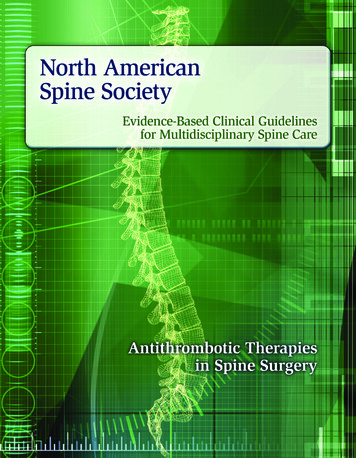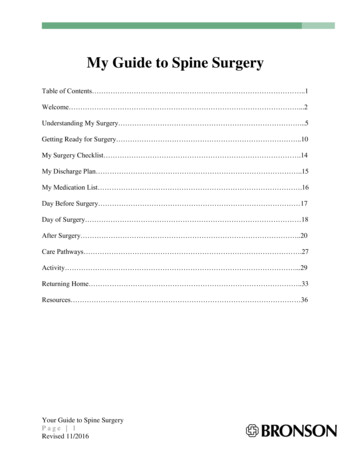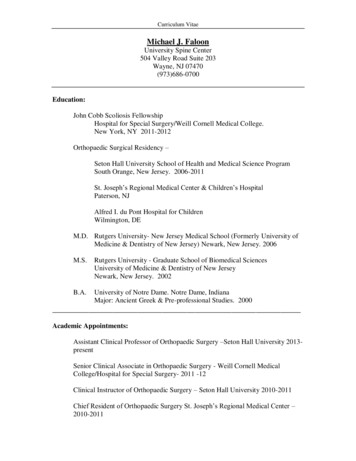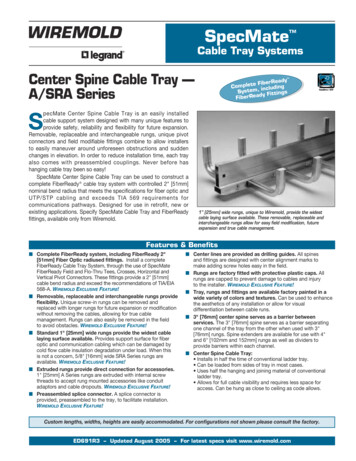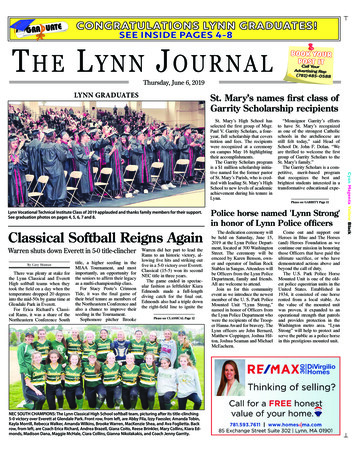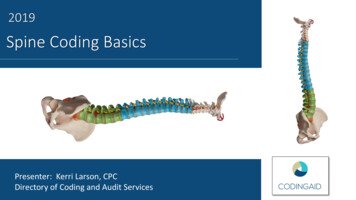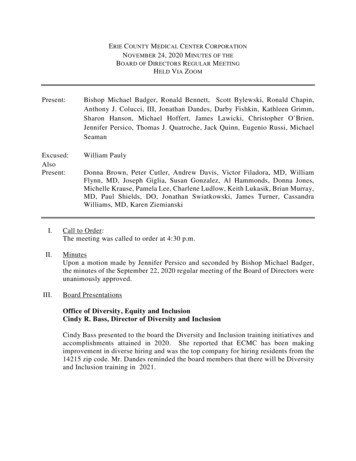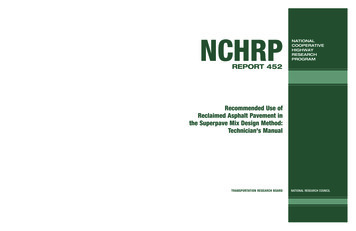
Transcription
15866 Lynn spine 5/32”NCHRP GreenTRANSPORTATION RESEARCH BOARDNational Research Council2101 Constitution Avenue, N.W.Washington, D.C. 20418ADDRESS SERVICE OGRAMREPORT 452Recommended Use ofReclaimed Asphalt Pavement inthe Superpave Mix Design Method:Technician's ManualTRANSPORTATION RESEARCH BOARDNATIONAL RESEARCH COUNCIL
TRANSPORTATION RESEARCH BOARD EXECUTIVE COMMITTEE 2001OFFICERSChair: John M. Samuels, Senior Vice President-Operations Planning & Support, Norfolk Southern Corporation, Norfolk, VAVice Chair: Thomas R. Warne, Executive Director, Utah DOTExecutive Director: Robert E. Skinner, Jr., Transportation Research BoardMEMBERSWILLIAM D. ANKNER, Director, Rhode Island DOTTHOMAS F. BARRY, JR., Secretary of Transportation, Florida DOTJACK E. BUFFINGTON, Associate Director and Research Professor, Mack-Blackwell National Rural Transportation Study Center, University of ArkansasSARAH C. CAMPBELL, President, TransManagement, Inc., Washington, DCE. DEAN CARLSON, Secretary of Transportation, Kansas DOTJOANNE F. CASEY, President, Intermodal Association of North AmericaJAMES C. CODELL III, Transportation Secretary, Transportation Cabinet, Frankfort, KYJOHN L. CRAIG, Director, Nebraska Department of RoadsROBERT A. FROSCH, Senior Research Fellow, John F. Kennedy School of Government, Harvard UniversityGORMAN GILBERT, Director, Oklahoma Transportation Center, Oklahoma State UniversityGENEVIEVE GIULIANO, Professor, School of Policy, Planning, and Development, University of Southern California, Los AngelesLESTER A. HOEL, L. A. Lacy Distinguished Professor, Department of Civil Engineering, University of VirginiaH. THOMAS KORNEGAY, Executive Director, Port of Houston AuthorityBRADLEY L. MALLORY, Secretary of Transportation, Pennsylvania DOTMICHAEL D. MEYER, Professor, School of Civil and Environmental Engineering, Georgia Institute of TechnologyJEFFREY R. MORELAND, Executive Vice President-Law and Chief of Staff, Burlington Northern Santa Fe Corporation, Fort Worth, TXSID MORRISON, Secretary of Transportation, Washington State DOTJOHN P. POORMAN, Staff Director, Capital District Transportation Committee, Albany, NYCATHERINE L. ROSS, Executive Director, Georgia Regional Transportation AgencyWAYNE SHACKELFORD, Senior Vice President, Gresham Smith & Partners, Alpharetta, GAPAUL P. SKOUTELAS, CEO, Port Authority of Allegheny County, Pittsburgh, PAMICHAEL S. TOWNES, Executive Director, Transportation District Commission of Hampton Roads, Hampton, VAMARTIN WACHS, Director, Institute of Transportation Studies, University of California at BerkeleyMICHAEL W. WICKHAM, Chairman and CEO, Roadway Express, Inc., Akron, OHJAMES A. WILDING, President and CEO, Metropolitan Washington Airports AuthorityM. GORDON WOLMAN, Professor of Geography and Environmental Engineering, The Johns Hopkins UniversityMIKE ACOTT, President, National Asphalt Pavement Association (ex officio)EDWARD A. BRIGHAM, Acting Deputy Administrator, Research and Special Programs Administration, U.S.DOT (ex officio)BRUCE J. CARLTON, Acting Deputy Administrator, Maritime Administration, U.S.DOT (ex officio)JULIE A. CIRILLO, Assistant Administrator and Chief Safety Officer, Federal Motor Carrier Safety Administration, U.S.DOT (ex officio)SUSAN M. COUGHLIN, Director and COO, The American Trucking Associations Foundation, Inc. (ex officio)ROBERT B. FLOWERS (Lt. Gen., U.S. Army), Chief of Engineers and Commander, U.S. Army Corps of Engineers (ex officio)HAROLD K. FORSEN, Foreign Secretary, National Academy of Engineering (ex officio)JANE F. GARVEY, Federal Aviation Administrator, U.S.DOT (ex officio)EDWARD R. HAMBERGER, President and CEO, Association of American Railroads (ex officio)JOHN C. HORSLEY, Executive Director, American Association of State Highway and Transportation Officials (ex officio)S. MARK LINDSEY, Acting Deputy Administrator, Federal Railroad Administration, U.S.DOT (ex officio)JAMES M. LOY (Adm., U.S. Coast Guard), Commandant, U.S. Coast Guard (ex officio)WILLIAM W. MILLAR, President, American Public Transportation Association (ex officio)MARGO T. OGE, Director, Office of Transportation and Air Quality, U.S. Environmental Protection Agency (ex officio)VALENTIN J. RIVA, President and CEO, American Concrete Pavement Association (ex officio)VINCENT F. SCHIMMOLLER, Deputy Executive Director, Federal Highway Administration, U.S.DOT (ex officio)ASHISH K. SEN, Director, Bureau of Transportation Statistics, U.S.DOT (ex officio)L. ROBERT SHELTON III, Executive Director, National Highway Traffic Safety Administration, U.S.DOT (ex officio)MICHAEL R. THOMAS, Applications Division Director, Office of Earth Sciences Enterprise, National Aeronautics Space Administration (ex officio)HIRAM J. WALKER, Acting Deputy Administrator, Federal Transit Administration, U.S.DOT (ex officio)NATIONAL COOPERATIVE HIGHWAY RESEARCH PROGRAMTransportation Research Board Executive Committee Subcommittee for NCHRPJOHN M. SAMUELS, Norfolk Southern Corporation, Norfolk, VA (Chair)LESTER A. HOEL, University of VirginiaJOHN C. HORSLEY, American Association of State Highway and TransportationOfficialsVINCENT F. SCHIMMOLLER, Federal Highway AdministrationROBERT E. SKINNER, JR., Transportation Research BoardMARTIN WACHS, Institute of Transportation Studies, University of California atBerkeleyTHOMAS R. WARNE, Utah DOTProject Panel D9-12Field of Materials and ConstructionArea of Bituminous MaterialsGALE C. PAGE, Florida DOTROBERT F. LAFORCE, Colorado DOT (Chair)JAMES B. SORENSON, FHWAHALEEM A. TAHIR, AASHTO MonitorJOHN BUKOWSKI, FHWA Liaison RepresentativeDALE S. DECKER, Oldcastle Inc. Materials Group, Washington, DCKEVIN D. STUART, FHWA Liaison RepresentativeRUDOLF A. JIMENEZ, University of ArizonaKENT R. HANSEN, NAPA Liaison RepresentativePAUL R. MATTHEWS, New Hampshire DOTFREDERICK HEJL, TRB Liaison RepresentativeLARRY L. MICHAEL, Maryland State Highway AdministrationProgram StaffROBERT J. REILLY, Director, Cooperative Research ProgramsCRAWFORD F. JENCKS, Manager, NCHRPDAVID B. BEAL, Senior Program OfficerHARVEY BERLIN, Senior Program OfficerB. RAY DERR, Senior Program OfficerAMIR N. HANNA, Senior Program OfficerEDWARD T. HARRIGAN, Senior Program OfficerCHRISTOPHER HEDGES, Senior Program OfficerTIMOTHY G. HESS, Senior Program OfficerRONALD D. McCREADY, Senior Program OfficerCHARLES W. NIESSNER, Senior Program OfficerEILEEN P. DELANEY, Managing EditorJAMIE FEAR, Associate EditorHILARY FREER, Associate EditorANDREA BRIERE, Assistant EditorBETH HATCH, Editorial Assistant
N AT I O N A L C O O P E R AT I V E H I G H WAY R E S E A R C H P R O G R A MNCHRPREPORT 452Recommended Use ofReclaimed Asphalt Pavement inthe Superpave Mix Design Method:Technician's ManualREBECCA MCDANIELNorth Central Superpave CenterWest Lafayette, INandR. MICHAEL ANDERSONAsphalt InstituteLexington, KYS UBJECT A REASMaterials and ConstructionResearch Sponsored by the American Association of State Highway and Transportation Officialsin Cooperation with the Federal Highway AdministrationT R A N S P O R TAT I O N R E S E A R C H B O A R D — N AT I O N A L R E S E A R C H C O U N C I LNATIONAL ACADEMY PRESSWASHINGTON, D.C. — 2001
NATIONAL COOPERATIVE HIGHWAY RESEARCHPROGRAMSystematic, well-designed research provides the most effectiveapproach to the solution of many problems facing highwayadministrators and engineers. Often, highway problems are of localinterest and can best be studied by highway departmentsindividually or in cooperation with their state universities andothers. However, the accelerating growth of highway transportationdevelops increasingly complex problems of wide interest tohighway authorities. These problems are best studied through acoordinated program of cooperative research.In recognition of these needs, the highway administrators of theAmerican Association of State Highway and TransportationOfficials initiated in 1962 an objective national highway researchprogram employing modern scientific techniques. This program issupported on a continuing basis by funds from participatingmember states of the Association and it receives the full cooperationand support of the Federal Highway Administration, United StatesDepartment of Transportation.The Transportation Research Board of the National ResearchCouncil was requested by the Association to administer the researchprogram because of the Board’s recognized objectivity andunderstanding of modern research practices. The Board is uniquelysuited for this purpose as it maintains an extensive committeestructure from which authorities on any highway transportationsubject may be drawn; it possesses avenues of communications andcooperation with federal, state and local governmental agencies,universities, and industry; its relationship to the National ResearchCouncil is an insurance of objectivity; it maintains a full-timeresearch correlation staff of specialists in highway transportationmatters to bring the findings of research directly to those who are ina position to use them.The program is developed on the basis of research needsidentified by chief administrators of the highway and transportationdepartments and by committees of AASHTO. Each year, specificareas of research needs to be included in the program are proposedto the National Research Council and the Board by the AmericanAssociation of State Highway and Transportation Officials.Research projects to fulfill these needs are defined by the Board, andqualified research agencies are selected from those that havesubmitted proposals. Administration and surveillance of researchcontracts are the responsibilities of the National Research Counciland the Transportation Research Board.The needs for highway research are many, and the NationalCooperative Highway Research Program can make significantcontributions to the solution of highway transportation problems ofmutual concern to many responsible groups. The program,however, is intended to complement rather than to substitute for orduplicate other highway research programs.Note: The Transportation Research Board, the National Research Council,the Federal Highway Administration, the American Association of StateHighway and Transportation Officials, and the individual states participating inthe National Cooperative Highway Research Program do not endorse productsor manufacturers. Trade or manufacturers’ names appear herein solelybecause they are considered essential to the object of this report.NCHRP REPORT 452Project D9-12 FY’97ISSN 0077-5614ISBN 0-309-06670-0Library of Congress Control Number 2001-131334 2001 Transportation Research BoardPrice 26.00NOTICEThe project that is the subject of this report was a part of the National CooperativeHighway Research Program conducted by the Transportation Research Board with theapproval of the Governing Board of the National Research Council. Such approvalreflects the Governing Board’s judgment that the program concerned is of nationalimportance and appropriate with respect to both the purposes and resources of theNational Research Council.The members of the technical committee selected to monitor this project and to reviewthis report were chosen for recognized scholarly competence and with dueconsideration for the balance of disciplines appropriate to the project. The opinions andconclusions expressed or implied are those of the research agency that performed theresearch, and, while they have been accepted as appropriate by the technical committee,they are not necessarily those of the Transportation Research Board, the NationalResearch Council, the American Association of State Highway and TransportationOfficials, or the Federal Highway Administration, U.S. Department of Transportation.Each report is reviewed and accepted for publication by the technical committeeaccording to procedures established and monitored by the Transportation ResearchBoard Executive Committee and the Governing Board of the National ResearchCouncil.Published reports of theNATIONAL COOPERATIVE HIGHWAY RESEARCH PROGRAMare available from:Transportation Research BoardNational Research Council2101 Constitution Avenue, N.W.Washington, D.C. 20418and can be ordered through the Internet Printed in the United States of America
FOREWORDBy StaffTransportation ResearchBoardThis is a technician’s manual for use of reclaimed asphalt pavement (RAP) inSuperpave -designed hot-mix asphalt (HMA). It will be of particular interest to materials engineers in state highway agencies and to contractor personnel responsible fordesigning HMA according to the current Superpave method.When hot-mix asphalt (HMA) pavements reach the end of their usable servicelives, the materials in them retain considerable value. In the early 1970s, states andpaving contractors began making extensive use of reclaimed asphalt pavement (RAP)as a component in new HMA pavements. Besides possible cost savings, this use of RAPrepresents an environmentally positive method of recycling. Further, experience hasshown that properly designed HMA containing RAP performs as well as HMA prepared exclusively with virgin materials.From 1987 through 1993, the Strategic Highway Research Program carried outseveral major research projects to develop the Superpave method for performancebased HMA design. This method has now widely superseded the Marshall and Hveemdesign methods in the United States and Canada. A distinct shortcoming of the Superpave method is that it makes no specific provision for the use of RAP in the mix designprocess. This shortcoming has hindered RAP use by agencies that have adopted theSuperpave mix design method.To remedy this situation, the Federal Highway Administration’s Superpave Mixtures Expert Task Group used past experience to develop interim guidelines for the useof RAP in the Superpave method. These guidelines reflect the fact that the effect ofaged binder from RAP on the performance properties of the virgin binder depends uponthe level of RAP in the HMA. When the level is low, the effect is minimal, and the RAPis likened to a “black rock” that influences the mix volumetrics and performancethrough its aggregate gradation and properties. As the level of RAP in the HMAincreases, the black rock analogy breaks down; the aged binder blends with the virginmaterial in sufficient quantity to significantly affect its performance properties.Under NCHRP Project 9-12, “Incorporation of Reclaimed Asphalt Pavement in theSuperpave System,” the North Central Superpave Center at Purdue University wasassigned the tasks of developing recommended guidelines for incorporating RAP in theSuperpave mix design method and preparing a technician’s manual to implement theseguidelines in routine laboratory operations.The research team first conducted a comprehensive laboratory-testing program totest the null hypothesis that RAP does not act as a black rock. RAP materials from fieldprojects in Florida, Connecticut, and Arizona that yielded recovered RAP binders ofdistinctly different stiffnesses were investigated in combination with two different virgin binders at RAP contents of 10 and 40 percent. Mix specimens fabricated to simulate three cases of blending—actual practice, black rock, and total blending—were
evaluated through the use of the Superpave shear tests (AASHTO TP7) at high temperatures and indirect tensile creep and strength tests (AASHTO TP9) at low temperatures. No statistically significant differences were found among the three blendingcases at low RAP contents. However, at higher RAP contents, the actual practice andtotal blending cases were statistically different from the black rock case, but not fromeach other. Thus, the results provided compelling evidence that RAP does not act likea black rock, regardless of the stiffness of the RAP binder. The research team theninvestigated the effects of hardened RAP binder on the blended binder properties andof RAP on the blended mix properties.The research findings largely confirm current practice as exemplified by the Superpave Mixtures Expert Task Group’s interim guidelines. Low amounts of RAP, typically 10 to 20 percent, can be used without characterization of its recovered binderproperties; there is not enough of the old, hardened RAP present to significantly changethe properties of the asphalt binder, and the RAP may be solely accounted for as a component of the aggregate. When RAP is added in amounts greater than 20 percent, recovery and testing of its binder is recommended, along with the use of blending charts todetermine what performance grade of virgin asphalt binder should be used in the mixdesign. The RAP aggregate properties should be considered as if the RAP is anotheraggregate stockpile. In the Superpave mix design, the RAP aggregates should beblended with the virgin aggregates so that the final blend meets the Superpave consensus properties. Most state highway agencies will find that the results of the researchlargely agree with their usual practice. This agreement should give highway agenciesand contractors greater confidence in more widely extending the use of RAP in HMA,regardless of the mix design method used.The technician’s manual published herein was prepared by the North Central Superpave Center research team as Appendix E of the final report for NCHRP Project 9-12.The team’s final report includes a detailed description of the experimental program, adiscussion of the research results, and seven supporting appendices: Appendix A, Annotated Bibliography; Appendix B, Statistical Analysis of Black Rock Data; Appendix C, Flow Charts Showing Development of Blending Charts; Appendix D, Summary: Guidelines for Incorporating Reclaimed Asphalt Pavementin the Superpave System; Appendix E, Use of RAP in Superpave: Technicians’ Manual; Appendix F, Use of RAP in Superpave: Implementation Plan; and Appendix G, Proposed Procedure for Determining the Asphalt Binder GradeRecovered from HMA.Appendix D will be published as NCHRP Research Results Digest 253. The mainreport and Appendixes A, B, C, F, and G will be published as NCHRP Web Document30. In addition, the entire final report, including all appendixes, will be distributed as aCD-ROM (CRP-CD-8) along with the complete final reports for NCHRP Projects 9-11and 9-13.
CONTENTS1CHAPTER 1 IntroductionManual Purpose, 1RAP, 12CHAPTER 2 Determining Properties of RAPRAP Variability, 2Sampling RAP, 2Roadway Sampling, 3Stockpile Sampling, 3Sampling from Haul Trucks, 3Sample Size, 3Extraction and Recovery of RAP Binder and Aggregates, 3Determining Aggregate Properties, 4RAP Aggregate Gradation, 4RAP Aggregate Specific Gravity, 4Consensus Properties, 4Moisture in RAP, 56CHAPTER 3 Determining RAP Binder PropertiesExtraction-and-Recovery Process when Testing RAP Properties, 6Determining Binder Properties, 7Binder Grade Selection, 10Method A: Blending at a Known RAP Percentage (Virgin Binder GradeUnknown), 10Determining RAP Content, 11Method B: Blending with a Known Virgin Binder Grade (RAP PercentageUnknown), 1113CHAPTER 4 Developing the Mix DesignDetermining Combined Aggregate Gradation, 13Verifying Aggregate Properties, 13Handling RAP in the Lab, 14Modifications to Standard Mix Design Procedures, 14RAP Batching, 14Step-by-Step Mix Design Procedure, 1517CHAPTER 5 Mix Design ExampleSelection of Materials, 17Determine Stockpile Gradations, 17Determine Stockpile Properties, 17Selection of Design Aggregate Structure, 18Establish Trial Blends, 18Estimate Trial Binder Content (Total), 18Calculate Batch Weights, 20Mix and Compact Trial Blend Specimens, 20Selection of Design Binder Content, 25Compact Design Aggregate Structure Specimens at Various BinderContents, 25Verify Mix Design, 2728CHAPTER 6 Field Quality-Control TestingField Testing of RAP Mixtures, 28Additional Quality-Control Procedures with RAP Mixtures, 2829REFERENCES30GLOSSARY32APPENDIX A Equations for RAP Specific Gravity33APPENDIX B Information Needed for RAP Mix Design36APPENDIX C How to Increase VMA37APPENDIX D Proposed Revised TP2, Standard Test Method forQuantitative Extraction and Recovery of Asphalt Binderfrom Asphalt Mixtures
AUTHOR ACKNOWLEDGMENTSThe authors gratefully acknowledge the support of all the peoplewho contributed to the success of NCHRP Project 9-12, “Incorporation of Reclaimed Asphalt Pavement in the Superpave System,”which served as the basis for the methods outlined in this manual.The efforts of Dr. Hamid Soleymani, North Central Superpave Center, and of Mr. Robert Peterson and Ms. Pamela Turner, the AsphaltInstitute, are especially appreciated.The authors also thank the states in the North Central region andthe Member Companies of the Asphalt Institute; without their support and interest, the research could not have been completed.The support and guidance of Dr. Edward T. Harrigan and of themembers of the project panel are also greatly appreciated.
1CHAPTER 1INTRODUCTIONMANUAL PURPOSEThis manual is a reference guide for mix design and fieldtesting technicians who deal with reclaimed asphalt pavement (RAP) in Superpave mixtures. It will provide detaileddescriptions and examples of each step involved in designing and testing a Superpave mix with RAP.This manual is written assuming that you, the reader, arealready familiar with basic asphalt mixture testing and mixdesign. If this is not the case, you may want to attend a training course or refer to other publications, such as SuperpaveLevel 1 Mix Design, SP-2 (1), Hot Mix Asphalt Materials,Mixture Design and Construction (2), Background of Superpave Asphalt Mixture Design and Analysis (3), or Hot-MixAsphalt Paving Handbook (4). A step-by-step manual covering basic asphalt mixture test procedures is also available fromFHWA (5). You should also have a copy of the AASHTOspecifications for hot-mix asphalt, aggregates, and binders (6),or a copy of your state’s specifications, or both.Mix designers will be especially interested in Chapters 1through 5. Quality-control technicians will be particularly interested in Chapters 1, 2, and 6. A glossary, which includes allequation variables used in the manual, follows the references.This manual summarizes recommended guidelines forworking with Superpave mixtures containing RAP. It isimportant to remember, however, that each state or agencyyou work with may have its own specifications and recommended practices that must be followed. You should be certain that you know the specifications for the agency withwhich you are working.RAPRAP is old asphalt pavement that is milled up or ripped offthe roadway. This material can be reused in new asphalt mixtures because the components of the mix—the asphalt binderand aggregate—still have value. Using RAP in new mixturescan reduce the amount of new material that has to be added,saving money and natural resources. In addition, hot-mixasphalt mixtures with RAP can perform as well as mixturesmade with all new material.When RAP is reused in a new mixture, it is necessary toproperly account for the old material in the new design. Theaggregate from the RAP has to be included with the newaggregate, and that blend of aggregate has to meet certainphysical properties. The old binder from the RAP may needto be tested and analyzed, too. The old binder may reduce theneed for new binder to be added. During the construction andservice life of the roadway from which the RAP was obtained,the asphalt binder in the roadway became aged or hardenedby reacting with oxygen in the air. If the old asphalt is veryhard or if there is a lot of it, blending the old asphalt with thenew binder that is added may make the blend act like a muchharder binder. This binder hardening can be counteracted byadding a softer binder to the mix and letting the RAP binderstiffen the softer binder. Sometimes, recycling agents also areused to soften the hardened RAP binder.The materials in the RAP most likely met the specifications at the time of construction. However, overtime, andespecially with the use of Superpave, the specifications havechanged. Superpave specifications usually are tighter thanthe previous hot-mix specifications used in most states. Inparticular, controls on aggregate gradation and shape arefrequently tighter than before. The new hot-mix asphalt produced with RAP must meet these new, tighter restrictions.For example, if the RAP gradation is very different from theSuperpave specifications, the amount of RAP that can beused may be limited.Past experience with RAP in Marshall and Hveem mixtures has shown that properly designed and constructed RAPmixes can perform as well as, or even better than, mixturesmade with all new materials. The same should be true ofSuperpave mixtures made with RAP.
2CHAPTER 2DETERMINING PROPERTIES OF RAPThis chapter describes how to sample and test RAP to getthe basic information needed for the mix design. Testing theRAP binder properties is required when using higher percentages of RAP (this topic will be described in Chapter 3).Your state may have specific guidelines for sampling andtesting.RAP sampling for Superpave mixtures is essentially nodifferent than sampling for conventional Marshall or Hveemmixtures. When collecting RAP materials to be used in themix design process, larger samples may be needed becauseSuperpave specimens are much larger than Marshall orHveem specimens.Some of the tests done for Superpave are different thanthose done for Marshall or Hveem designs. In using Superpave, the blends of aggregates must meet certain gradationlimits and consensus properties; these same requirementsalso apply to blends with RAP. Superpave binders also needto meet certain properties. If a high percentage of RAP isused (greater than 15 to 30 percent, depending on virginbinder grade), the RAP binder will have to be consideredwhen choosing the virgin asphalt grade.RAP VARIABILITYOne concern many agencies have about the use of RAP isthe variability of the material. Because RAP is removed froman old roadway, it may include the original pavement materials, plus patches, chip seals, and other maintenance treatments. Base, intermediate, and surface courses from the oldroadway may all be mixed together in the RAP. RAP fromseveral projects is sometimes mixed in a single stockpile,although this mixing is not encouraged. Mixed stockpilesmay also include materials from private work that may nothave been built to the same original standards.Because of variability concerns, some states limit theamount of RAP that can be included in new mixtures. Somestates allow the use of higher percentages of RAP if the material is milled off the same project where the new mix will beplaced; if RAP is used from a stockpile that includes material from several projects, less RAP may be used.RAP stockpiles may also include what is called “deleteriousmaterial.” Deleterious material includes anything that does notbelong in the stockpile—aluminum cans, wood scraps, port-land cement concrete, trash, and the like. These materials areundesirable in the finished product, and their presence in thestockpile should be limited.Variability is a concern for both the agency and the contractor. If the RAP varies widely in properties, such as gradation or asphalt content, the resulting hot-mix asphalt mayalso be variable. This variability will make it harder for thecontractor to meet specifications. In states that incorporatepenalties and bonuses (e.g., disincentives and incentives) formeeting the specifications, variability can lead to reducedpay for the material produced; therefore, it can be to the contractor’s advantage to control variability as much as possible.Good stockpile management practices should be followedto keep material variability in check. Research has shownthat the variability of RAP can be controlled and may not beas great as expected (7).Stockpiles should be built with materials from one source(i.e., one project) to keep them as consistent as possible.Achieving this consistency is frequently difficult, however,because there is not enough room at the plant to build separate stockpiles. Mixing materials from multiple projects isundesirable because it can greatly increase the variability ofthe stockpile. If materials from several projects are combinedin a stockpile, they should be blended together using a frontend loader or other equipment. Processing the RAP by crushing or screening can also greatly help to mix the pile andremove oversized material. The National Asphalt PavementAssociation has an excellent publication entitled RecyclingHot Mix Asphalt Pavements (8) that discusses processing andhandling RAP at the plant and during construction.Some states require that stockpiles be tested and identified.After the stockpile is sampled for testing, it may be assigneda number. New materials cannot be added to that stockpile.Be sure to find out what your state requires for stockpile management and what limits the agency places on variability ofRAP properties or on the maximum allowable percentage ofRAP in specific mixtures.SAMPLING RAPRAP can be sampled from the roadway (by coring beforethe pavement is milled), from a stockpile, or from haul trucks.The process for stockpile or haul-truck sampling is similar to
3the sampling process used for aggregates. It is important toget samples that accurately reflect the material that is available for use. For example, in a stockpile of RAP, some segregation may have occurred, and there may be parts of thepile that are coarser than the rest of the pile. (RAP materialsare not as likely to segregate as aggregates because theasphalt binder in RAP helps keep coarse and fine aggregatebound together.) When sampling a pile, it is important tosample from several locations to try to avoid taking the entiresample from a segregated area.FHWA’s Pavement Recycling Guidelines for State andLocal Governments (9; pp. 5-1 through 7-26) includes adetailed discussion of sampling RAP. Many of the rec
15866_Lynn_spine 5/32" NCHRP Green . John F. Kennedy School of Government, Harvard University GORMAN GILBERT, Director, Oklahoma Transportation Center, . the Federal Highway Administration, the American Association of State Highway and Transportation Officials, and the individual states participating in .

